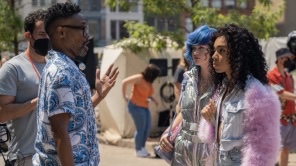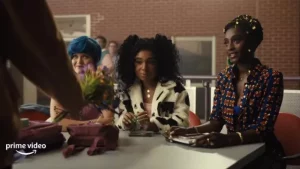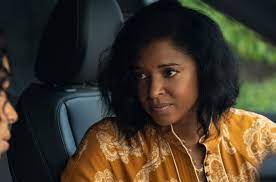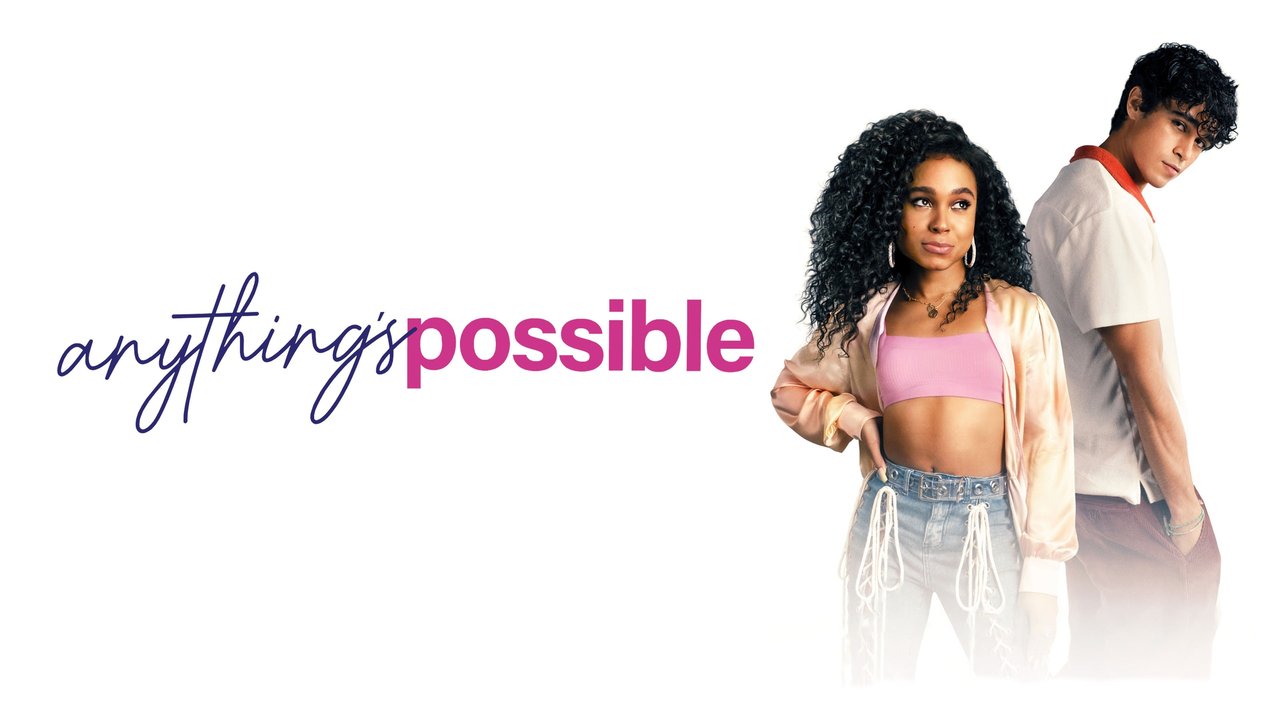**Spoiler Alert**
At the close of the second act, what I believe to be the central theme of Anything’s Possible hit me. It’s a moment right after Khalid (Khal), played by Abubakr Ali, scuffles it up with his now ex-BFF Otis (Grant Reynolds). I’ll get to that in a sec…
Anything’s Possible is Billy Porter’s directorial debut. It’s a high school rom-com with a remixed trope: boy meets cute girl (who just so happens to be trans), boy loses cute girl, boy gets cute girl back. Cue Janet Jackson’s “Free Xone” from Velvet Rope. And their meet-cute is pretty simple; the moment Kelsa’s (Eva Reign) blush of a smile and sparklers bedazzles Khal, it’s on like buttered popcorn. Or at least goofily apparent they are destined for, at least, the next 98 minutes.

One signature of this Porter-directed high school rom-com is that these kids were “serving looks,” as they say. Kelsa’s besties Em (Courtnee Carter) and Chris (Kelly Lamor Wilson) are funky-fly-fresh with their own soundtrack. Still, our introduction to this bouncy, rhythmic trio of blue-haired, spacesuit-bedecked, midriff-baring with a boa crew is as expected for teenage besties in cahoots. Porter’s light, artsy, syncopated entree into this genre was a little Sixteen Candles a skosh of High School Musical, mixed with a sprinkle of Crush.
In an interview on Late Night with Seth Meyers, Porter describes Anything’s Possible as his love letter to his hometown of Pittsburgh which, by the way, is in the top 10 of the “best cities for artists.” Some characters were his friends, including Khal’s mom, Selda (Miriam Laube), Kelsa’s mom, Selene (Renée Elise Goldsberry), and the delightful art teacher, Ms. Kidd (Lenora Nemetz). Porter worked with Laube at an amusement park, Kennywood Park, attended Carnegie Mellon with Goldsberry, and was once mentored by Nemetz.

Anything’s Possible is hopeful; a story of a trans girl navigating high school facing the same issues any other typical teen could face: parents who critique their clothes and sneak peeks at their computers, college choices, and of course, first love. The awkward and exciting time in a high schooler’s life also creates a space for Kelsa’s challenges as she prepares to leave her mother’s protective cocoon. But before this butterfly takes flight, of course, there’s a little drama and some conflict. I mean, it is about teenagers.
The conflict heats up when Em’s theory (your first Insta-story is who you’re “thirsty” for) and her lightning-speed declaration out-paces Kelsa’s. Them both liking Khal, which is the pickle. Then, Khal takes it up a notch when he gives Kelsa the flowers Em assumed were for her in front of the entire freaking school (ill-advised). Anything’s Possible then also layers with “girl meets her BFF, girl loses her BFF, girl gets her BFF back” (cue Janet Jackson). Sidenote: Em’s Insta-story theory is questionable unless I’m supposed to end up with the NY Times, although in Chris’s words, “that tracks,” I guess (insert eye-roll emoji here.)

Luckily, everyone reconciles as they prepare for life beyond high school. Kelsa’s mom and anyone living in this actual moment knows life today is precarious beyond those walls and the silver screen. To borrow a phrase, the personal is absolutely political these days. We are witnessing an incredulously biased, divisive, and just plain stupid banned book/don’t say gay/anti-choice moment in time. But, I digress, intentionally…
Porter offers us an antidote hearkening to my opening thought. After his fight with the disappointingly non-redemptive Otis, Khal’s upset. I was pleasantly surprised when his family, especially his mother, embraced and accepted him after confessing his love for Kelsa, a trans girl. His confession was not gratuitous but in response to his parents’ assumption that he was gay after sneaking a look at his web browser. In a poignant moment between Khal and his mother, she embraced him literally and figuratively. That’s when I recognized part of the message, we should receive is that anything is possible with a mother’s (or mother figure’s) love (good, better, or flawed). Kelsa’s, Em’s, and Khalid’s moms all stood in the gap for their kids, be it insightfully, “helicopter-ly,” or slightly frightfully.

Ultimately, Anything’s Possible is light and joy-filled (an intention of Porter’s) rather than a drama or tragedy. Not to say that everything was perfectly resolved in the end, but that’s real because high school is merely a moment in time, a jumping-off place. Having said that, I had one question each time I watched: How the heck is Otis holding his pencil? My 5th-grade writing teacher, Mrs. Manning (who always reminded me of Carol Burnett), would be having a conniption.
Now, this conundrum sent me down a “how to hold a pencil” YouTube rabbit hole. And here’s the thing, I actually learned a similar message from the pencil video as I did from Anything’s Possible. There’s plenty of room for us to all be our authentic selves and also accept others “as is” because we all have a purpose in life…and there’s plenty of ways to hold a pencil. And that’s my clunky way of saying the film’s Incluvie rating is off the charts. It features Black, Muslim, queer, trans humans whose moms hold them up, fight for them, and love them for who they are…making anything possible.


Comments